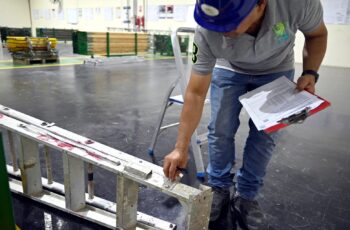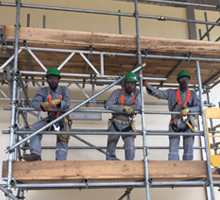Upcoming Trends in Scaffolding Materials, Technology, & Techniques Impacting Safety and Efficiency on Job Sites.
Robotic Assistance & Automation
Robotic Construction Support: Robots are being used to assist with tasks like material handling, assembly, and disassembly of scaffolding. This automation speeds up processes and ensures tasks are carried out accurately, reducing the risk of human error.
Drones for Inspections: Drones are becoming an essential tool for inspecting scaffolding from above. They can quickly check the stability and condition of scaffolding, reducing the need for manual checks in difficult-to-reach areas
Smart Scaffolding
IoT Integration: Scaffolding systems are being enhanced with smart technology. Internet of Things (IoT) sensors are being integrated to monitor the condition of scaffolding in real time, tracking parameters like load capacity, structural integrity, and environmental conditions. This ensures any issues are flagged before they become safety hazards.
Data-Driven Safety: AI and machine learning can predict risks based on data collected from the scaffolding system, enabling preemptive action and enhancing overall site safety.
Advanced Fall Protection Systems
Smart Harnesses: Smart harnesses equipped with sensors can detect if a worker has fallen or is in a potentially hazardous position, triggering alarms or alerts for immediate intervention.
3D Scanning and BIM (Building Information Modeling)
Precise Measurements: 3D scanning technologies are allowing construction companies to obtain accurate, real-time data on building dimensions. This helps to create scaffolding setups that are perfectly tailored to the structure, reducing the likelihood of errors and improving safety.
BIM Integration: The integration of Building Information Modeling (BIM) into scaffolding design ensures that scaffolding systems are planned with precision, with real-time collaboration between architects, engineers, and scaffolding professionals.
Augmented Reality (AR) and Virtual Reality (VR) in Training
Simulated Learning: AR and VR are becoming increasingly important in scaffolding training. Scaffolders can practice assembly and disassembly in a virtual environment, improving their skills without the risks associated with live training.
On-Site AR: Workers on-site can use AR glasses or devices to view scaffolding assembly instructions or safety protocols overlaid on their field of view, guiding them in real-time.
Enhanced Worker Protection with Wearables
Smart Wearables: Smart helmets, vests, and gloves are equipped with sensors to monitor the health and safety of workers. These wearables can detect signs of fatigue, alert workers to potential hazards, and even track their location to ensure they are within safe zones.





